Here’s the thing – meats and poultry are amazing when they spin while cooking. Think about it, rotisserie grilling is one of the oldest methods of cooking. Up until sometime in the 1950’s, people still used the rotisserie as their number one way of cooking large pieces of meat outdoors. The dome-shaped lid of kettle-style grills changed all that and soon you could cook a large cut of meat on the grill with indirect heat.
By the way, if you don’t have a rotisserie attachment… get one! Just kidding (no I’m not). Check out my post for Ancho and Sage Rubbed Turkey for how to grill roast a turkey with indirect heat.
So why have a rotisserie? Because meat, cooked on a spit slowly turning above the heat achieves a flavor and tenderness that it pretty much unequaled. That is why rotisserie chicken restaurants are so popular. Food is not actually grilled when cooked on a rotisserie – it roasts. The meat is more evenly cooked and becomes juicy and tender because of the self-basting action that happens while constantly turning on the spit.
I didn’t brine this turkey and it was moist and delicious due to the self-basting action. Feel free to brine your bird and use whatever seasonings you’d like, however, the seasoning in this recipe is easy and foolproof.
Note: brined birds brown faster, so keep and eye out. If the turkey is browning too quickly, stop the rotisserie and wrap the bird in foil. Start the motor and continue cooking.
Lemon-Herb Rotisserie Turkey
One 12 to 14 pound fresh or thawed turkey
2 tablespoons lemon pepper
2 teaspoons kosher salt
2 teaspoons fine herbs or poultry seasoning
1 teaspoon garlic powder
Extras:
Rotisserie attachment
Butcher’s twine
Drip pan
Method: indirect rotisserie grilling
Set up grill for indirect medium heat (maintain temperature from 325°F to 350°F). Center drip pan below where the turkey will be spinning on the rotisserie. I leave the grates off for maximum clearance. It takes a couple hours to cook so make sure you have enough gas in the tank! If using charcoal, bank the coals on both sides of the drip pan.
Remove neck and giblets from the cavity of the turkey; set aside of side for my Classic Giblet Gravy. Rinse the bird inside and out and dry with paper towels… inside and out; pat dry with paper towels. Remove the wing tips by cutting through the V of the joint. The tips have a tenancy to burn; set aside with the neck and giblets.
Mix together the rub ingredients together in a small bowl. Season the cavity with a couple teaspoons and set the remaining rub aside while you truss the turkey.
Trussing the bird is essential to not only keep things from flopping around, but to also keep the extremities from burning and keeping the turkey as juicy as possible. Admittedly, I do not present a whole roasted turkey at the table, I bring it out already carved. This method is easy, but will leave a line across the breast. If presentation is important to you, check out this video for classic trussing technique.
If it doesn’t matter to you, start by cutting a 4-foot length of butcher’s twine. Center the string and tie the drumsticks together.
Run the string between the drumsticks and breast. Catch the elbow of the wing and cross underneath the turkey. Come back around to the top and catch the rest of the wing. Tie off on top or cross under once more and tie. Trim extra string.
Season the turkey on all sides with the remaining rub. Be sure to get between the drumsticks and breast and around the wings.
Place one set of tine on the rotisserie spit and figure out the center position for the turkey. Tighten into place; I use pliers to make sure that it is tight, otherwise it could come loose and the bird will stop spinning.
Run the spit through the cavity from neck to tail and stay as close to the breast as possible. Since the breast side is the heaviest, this will give the best balance on the spit. You will probably have to use a counter balance weight on the back side. Push in the tines and secure.
Test the balance by rotating the spit in your hands. If it’s unbalanced, re-thread it and tighten the prongs.
Insert the spit on the grill. Start the motor and close the grill cover.
After 45 minutes, check to see how it the turkey is browning. Mine was browning too fast at the neck, so I lowered the heat on that side and raised it a bit on the other.
Total cooking time should be around 12 to 4 minutes per pound. To test for doneness, the temperature of the thigh, away from the bone, should be 170°F and the breast should be between 155° to 160°F. Remember – carryover cooking will continue to raise the temperature of the turkey another 5° to 10° after it comes off the grill.
Cheers and Happy Grilling!
~Jeff











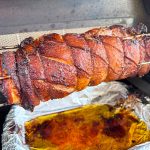
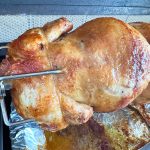
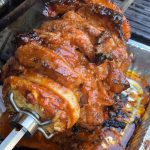
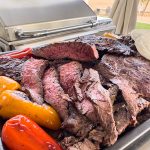
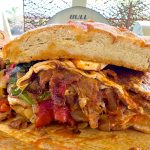
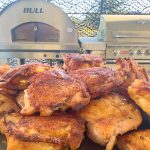
Superb .. (Although I don’t really eat turkey!).
I think most people only eat it out of obligation for American Thanksgiving. LOL
Bit like people eating it here at Christmas! Nobody really digs it!